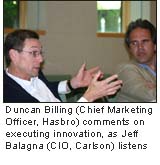
|
|
|
 |
|
 |
Nurturing and Executing Innovation
Thought Leadership Roundtable on Digital Strategies June 6, 2006 - Pawtucket, RI hosted by Hasbro Incorporated CIOs and other senior execs from 3M, Bechtel, Carlson, Cisco, Eastman Chemical, Hasbro, IBM, and OMD were joined by academics from Tuck and Michigan for this roundtable. |
||
|
Press Release
Agenda
List of Participants
Discussion Guide
Overview Article
|
|||||
In this roundtable, we discussed how companies can maximize the chance their product launches and new business launches succeed. The participants' experiences and views yielded the following insights (see the Overview Article for a complete summary):
- Multiple constituencies have a role in the ideation process. Top performers reach out to employees, customers, partners, even outside inventors for ideas.
- Employees with direct interaction with customers are often most productive in generating ideas. They have the most immediate understanding of the needs of the customer.
- When giving permanent innovation groups their charter, executives must navigate a fine line between immediate business relevance and long-term transformation. If innovators are tied too tightly to immediate business needs, the chances of a revolutionary breakthrough are drastically reduced.
- Anyone can generate an idea, but voices of experience should judge them. It takes years of observing customers and the way they interact with innovations to have a reliable sense for what will work and what will not.
- Before putting real dollars behind an innovation initiative, consider its fit with strategy and organizational capabilities.
- When innovations do not fit the existing innovation model, build a new business unit. The new business unit must be constructed with distinct organizational policies and practices. It must also be carefully linked to the core business.
The evening before the roundtable, Ed Glassmeyer, Managing General Partner at Oak Investment Partners, and Casey Powell, CEO of Xiotech Corporation, gave a presentation on, and lead the participants in a discussion on, "A VC View on Technology Today".
![]()
| Collaborative Knowledge Networks Project - center project to discover and understand the novel ways people join and work | |